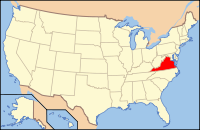Shenandoah County, Virginia
| Shenandoah County, Virginia | ||
|---|---|---|

Shenandoah County Courthouse in Woodstock
|
||
|
||
 Location in the U.S. state of Virginia |
||
 Virginia's location in the U.S. |
||
| Founded | 1772 | |
| Named for | Senedos Indian tribe | |
| Seat | ||
| Largest town | Strasburg | |
| Area | ||
| • Total | 512 sq mi (1,326 km2) | |
| • Land | 509 sq mi (1,318 km2) | |
| • Water | 3.4 sq mi (9 km2), 0.7% | |
| Population (est.) | ||
| • (2015) | 43,190 | |
| • Density | 84/sq mi (32/km²) | |
| Congressional district | 6th | |
| Time zone | Eastern: UTC-5/-4 | |
| Website | www |
|
Shenandoah County (formerly Dunmore County) is a county located in the Commonwealth of Virginia. As of the 2010 census, the population was 41,993. Its county seat is . It is part of the Shenandoah Valley region of Virginia.
The Senedos, possibly an Iroquoian group, are thought to have occupied the area at one time, until they were said to have been slaughtered by the Catawba in the later 17th century. The name of both the Valley and of the County is most likely connected with this Native American group. It has also been attributed to General George Washington naming it in honor of John Skenandoa, an Oneida chief from New York who helped gain support of Oneida and Tuscarora warriors to aid the rebel colonists during the American Revolutionary War.
Colonial Governor Gooch formally purchased the entire Shenandoah Valley from the Six Nations of the Iroquois by the Treaty of Lancaster in 1744. The Iroquois controlled the valley as a hunting ground. European settlement had already begun by that time. During Pontiac's War (1763-1766), Shawnee attacks reached as far east as the current county.
Shenandoah County was established in 1772. It was originally named Dunmore County for Virginia Governor John Murray, 4th Earl of Dunmore. was the county seat. Dunmore was Virginia's last royal governor, and was forced from office during the American Revolution. During the war, in 1778 rebels renamed the county as Shenandoah.
...
Wikipedia

